

Google Summit and Digicon - two recent presentations. Over the last couple of months I have presented sessions at two technology conferences.
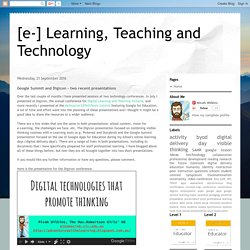
In July I presented at Digicon, the annual conference for Digital Learning and Teaching Victoria, and more recently I presented at the Melbourne EdTechTeam Summit featuring Google for Education. A lot of time and effort went into the planning of these presentations and I thought it might be a good idea to share the resources to a wider audience. There are a few slides that are the same in both presentations: school context, vision for e-Learning, the challenges we face, etc. The Digicon presentation focused on combining visible thinking routines with e-Learning tools (e.g. Pinterest and Storybird) and the Google Summit presentation focused on the use of Google Apps for Education during my school's online learning days ('digital delivery days').
If you would like any further information or have any questions, please comment. Here is the presentation for the Digicon conference: A-Z of lesser known Googley Goodness - Google Slides. GAFE Summit 2016 - Heather Bailie. Holly Clark GAFE Summit Resources. GAFE Summit - Disrupt Keynote. Kimberley Hall's Reimagine Reading presentation. Getting going with the Digital Technologies Curriculum. Tables. Chris Harte's Gafesummit Workshops. Jay Atwood Resource Site. Disruptive Thinking in Education. Change Management Full - Google Slides. RICOH THETA. Shooting Capture your entire surroundings with one simple push of the shutter.

You can now use remote shooting and manual shooting by using the app. Viewing Spherical images can be viewed using the app. Enjoy your spherical images in any way you want by swiping and pinching in the app. Sharing Spherical images can be posted to social networking services from the app and shared easily with friends. Download Enjoy. 360º Videos. 360° cockpit view. Taking it to the Street (View) - Mister Sill. Show Your Work! a book by Austin Kleon. Buy now: Amazon – B&N – IndieBound – Powell’s – BookPeople Download the cover and other images in the blogger kit.
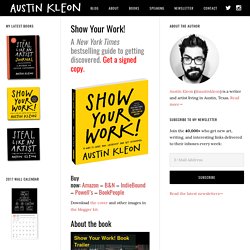
About the book ISBN: 9780761178972 | Foreign translations A book for people who hate the very idea of self-promotion, Show Your Work! Is the followup to my New York Times bestselling guide to creativity, Steal Like An Artist. In ten tight chapters, I lay out ways to think about your work as a never-ending process, how to build an audience by sharing that process, and how to deal with the ups and downs of putting yourself and your work out in the world: You don’t have to be a genius.Think process, not product.Share something small every day.Open up your cabinet of curiosities.Tell good stories.Teach what you know.Don’t turn into human spam.Learn to take a punch.Sell out.Stick around. Kenneth Shelton. Trex Slam - Google Slides. PhotoMath.net. Going SOLO with Classroom - Google Slides. YouTube. Let's Make Movies. ClapMotion. Stop Motion Animator. Online Print & Digital Publishing Software.
Free Online Video Editor and Maker. Polarr Online Photo Editor 2. Sumo Paint. Soundtrap - Make music online. Rich Media Production in the Cloud - Summit Stuff. Solve for X. Computer Science Unplugged. Google CS First. For Education: Computational Thinking (CT) is a problem solving process that includes a number of characteristics and dispositions.

CT is essential to the development of computer applications, but it can also be used to support problem solving across all disciplines, including math, science, and the humanities. Students who learn CT across the curriculum can begin to see a relationship between subjects as well as between school and life outside of the classroom. CSER Digital Technologies: Implementing the Australian Curriculum Learning Area - Course. Resources: Australian Curriculum Digital Technologies. The Digital Technologies curriculum exists within the Technologies learning area of the Australian Curriculum.
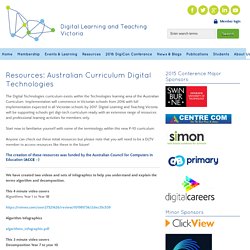
Implementation will commence in Victorian schools from 2016 with full implementation expected in all Victorian schools by 2017. Digital Learning and Teaching Victoria will be supporting schools get digi-tech curriculum ready with an extensive range of resources and professional learning activities for members only. Start now to familiarise yourself with some of the terminology within this new P-10 curriculum. Anyone can check out these initial resources but please note that you will need to be a DLTV member to access resources like these in the future! The creation of these resources was funded by the Australian Council for Computers in Education (ACCE) We have created two videos and sets of infographics to help you understand and explain the terms algorithm and decomposition. This 4 minute video covers Algorithms Year 1 to Year 10 Algorithm Infographics algorithms_infographic.pdf.
Technologies: Rationale. Rationale Introduction to Design Technologies.
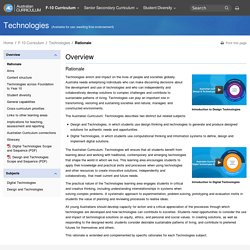
Google reveals smart contact lens prototype designed to aid diabetics. Stanford Undergrad. About CS+X at Stanford An experiment in learning, known informally as "CS+X", is aimed at integrating the humanities and computer science while providing students with unique educational experiences.
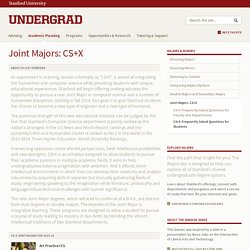
Stanford will begin offering undergraduates the opportunity to pursue a new Joint Major in computer science and a number of humanities disciplines, starting in fall 2014. Animator Danielle Feinberg illuminates how Pixar tells stories. You’ve probably seen a great deal of Danielle Feinberg’s work without knowing it—in fact, it might be more accurate to say that you’ve seen a great deal by virtue of her work.
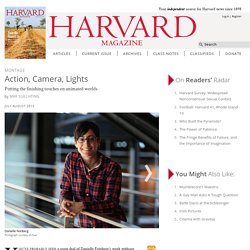
Feinberg ’96 is a director of photography at Pixar, where for almost a decade and a half she’s designed lighting for many of the studio’s most successful animated worlds, from A Bug’s Life (1998) and Monsters, Inc. (2001) through Wall-E (2008) and Brave (2012). Feinberg’s role is unusually specialized. Whereas the cinematographer for a live-action film is in charge of both camera and lighting, Pixar’s production system splits these responsibilities between two people, one handling the movement, angle, and focus of the virtual camera near the beginning of the pipeline, the other handling lighting at the very end.